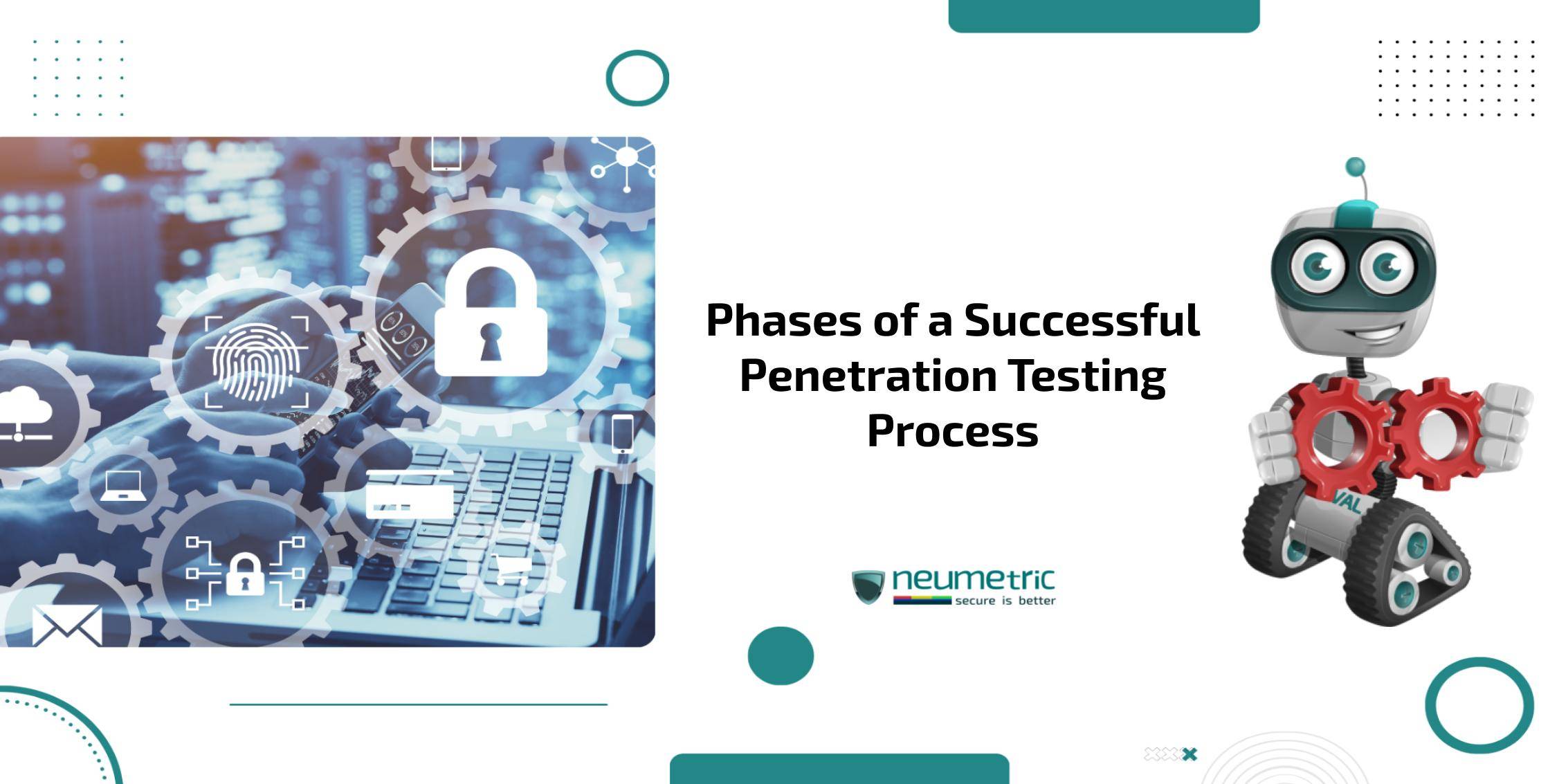Table of Contents
TogglePhases of a successful penetration testing process
Introduction
Penetration testing, often referred to as ethical hacking, is a controlled & systematic approach to simulating cyberattacks on a system, network or application. The primary goal is to uncover vulnerabilities, assess security measures & provide organisations with valuable insights to fortify their defences. While the concept of hacking may sound ominous, penetration testing is a positive & necessary endeavour aimed at enhancing cybersecurity resilience.
The significance of penetration testing lies not just in its execution but in the structured approach it follows. A haphazard attempt to identify vulnerabilities may lead to oversight or inadequate coverage. Therefore, penetration testing is divided into distinct phases, each serving a specific purpose in the comprehensive evaluation of an organisation’s security posture. This structured approach ensures thorough coverage & allows security professionals to methodically address potential risks.
Phase 1: Getting started
The initial phase of penetration testing is like setting the stage for a grand performance. It’s here that we define the rules of engagement, clarify our objectives & make sure everyone is on the same page. Let’s break down what happens in this crucial starting point.
Definition & objectives: In essence, this phase is all about laying the groundwork. We start by defining the scope of the penetration test – what exactly are we aiming to achieve? Are we focusing on a specific network, system or application? The objectives need to be crystal clear. Are we testing for vulnerabilities, checking the resilience of existing security measures or a bit of both? It’s like drawing a treasure map; you need to know where ‘X’ marks the spot.
The role of planning, scoping & objective setting: Planning is the backbone of any successful endeavour & penetration testing is no different. We chart out a roadmap, identifying the areas we’ll explore & the methods we’ll use. Scoping involves setting the boundaries – what’s in & what’s out. Think of it like a detective determining the crime scene. Objectives tie everything together, guiding us toward the goals we want to achieve. This phase is where the blueprint for the entire testing process takes shape.
Tips for effective communication with stakeholders: Communication is key, especially when it involves the security of an organisation’s digital infrastructure. We need to talk with everyone involved – from IT personnel to top-level management. Explaining the purpose, goals & potential outcomes in plain language is crucial. Transparency is our ally; when stakeholders understand why we’re doing what we’re doing, it fosters collaboration & support. It’s a bit like orchestrating a team effort rather than working in isolation.
Obtaining proper authorization: This is a step we cannot afford to skip. Getting the green light from the relevant authorities ensures we’re not crossing any ethical or legal boundaries. Just like a superhero needs permission before swooping in to save the day, penetration testers must have the authorization to access systems & networks. It’s not just a formality; it’s a commitment to operating within ethical bounds & respecting the organisation’s rules of engagement.
In essence, Phase 1 is about setting the right expectations, defining the rules & ensuring everyone is on board before we dive into the nitty-gritty of finding & fixing vulnerabilities. It’s the groundwork that paves the way for a successful penetration testing process.
Phase 2: Scanning & enumeration technique
Now that the stage is set, it’s time to roll up our sleeves & dig into the heart of the matter – scanning & enumeration. Think of this phase as the detective work in our cybersecurity investigation. We’re about to unveil the secrets of the network & systems.
The significance of thorough network & system analysis: Thoroughness is the name of the game. In this phase, we’re not just casually strolling through the digital landscape; we’re putting on our detective hats & examining every nook & cranny. The significance lies in uncovering vulnerabilities that may lurk beneath the surface. It’s about leaving no stone unturned, ensuring that when we identify a potential weak spot, we’ve done so with meticulous precision.
Tools & methodologies for scanning & identifying potential vulnerabilities: Every craftsman needs the right tools & in the realm of penetration testing, it’s no different. We have an arsenal of scanning tools at our disposal, each designed for a specific purpose. From network scanners that unveil the layout of the digital terrain to vulnerability scanners that sniff out potential weaknesses, these tools are our trusted companions. Methodologies guide our approach – a systematic way of applying these tools to ensure comprehensive coverage.
Mapping the target environment: Imagine mapping out a foreign city before planning a heist (the legal & ethical kind, of course). Similarly, in penetration testing, we map the target environment meticulously. This involves identifying open ports, understanding the services running on those ports & pinpointing potential entry points. It’s like creating a virtual blueprint of the system, helping us strategize our next moves. The goal is not just to find vulnerabilities but to understand the terrain we’re navigating.
In essence, Phase 2 is about becoming digital cartographers & detectives, methodically scanning & mapping the landscape. The more we know about the network & systems, the better equipped we are to uncover vulnerabilities & fortify the defences against potential cyber threats. It’s a journey into the intricate web of technology, where every click & scan brings us closer to understanding the digital terrain we’re navigating.
Phase 3: Exploitation demystified
Now that we’ve laid the groundwork & meticulously mapped out our target’s digital landscape, it’s time to put on our hacker hats – ethically, of course. Phase 3, the Exploitation Phase, is where we delve into the art of ethical hacking, unravelling the secrets of successful exploits while keeping our moral compass intact.
Ethical hacking techniques during the exploitation phase: Imagine you’re the locksmith testing the security of a bank vault. You’re not there to steal anything; you’re there to make sure the vault can withstand a real attempt. Ethical hacking is the same – we’re not the bad guys; we’re the cybersecurity experts testing the digital vaults. In this phase, we employ a range of ethical hacking techniques. It could be exploiting software vulnerabilities, manipulating configurations or even leveraging social engineering to understand how secure our target truly is.
Real-world examples of successful exploits: To truly understand the power of ethical hacking, let’s dive into some real-world examples. Consider a scenario where a flaw in a web application allows an attacker to gain unauthorised access to sensitive information. By exploiting this vulnerability, the ethical hacker identifies the weakness, brings it to the attention of the organisation & works with them to fix it before the bad guys can exploit it.
Responsible disclosure practices & ethical considerations: Being an ethical hacker comes with a responsibility – the responsibility to disclose vulnerabilities responsibly. This means informing the organisation or vendor about the discovered vulnerabilities without causing harm. It’s a delicate dance between uncovering weaknesses & ensuring they are patched before they can be exploited by malicious actors. Ethical considerations are at the forefront – we’re not here to wreak havoc but to make the digital world a safer place.
In the Exploitation Phase, we’re not just hacking for the thrill of it; we’re hacking with a purpose. It’s a controlled, methodical approach to uncovering vulnerabilities that could otherwise be the gateway for cyber threats. Through ethical hacking, we not only identify weaknesses but contribute to building a more resilient & secure digital landscape. It’s a journey into the shadows of cybersecurity, where every successful exploit is a step towards fortifying our defences.
Phase 4: Post-exploitation best practices
Congratulations, ethical hacker! You’ve successfully navigated through the complexities of exploiting vulnerabilities & now it’s time to don the detective hat once again in the Post-exploitation phase. This is where the real finesse comes into play, as we ensure that our actions are not just about breaking in but also about understanding & fortifying.
Actions taken by penetration testers after a successful exploit: Picture this as entering a secret room behind the vault after figuring out its combination. In this phase, penetration testers take careful & calculated steps after a successful exploit. This might involve creating backdoors, manipulating user privileges or even leaving subtle traces to see if the organisation’s security team can detect & respond to these actions. It’s not about causing chaos; it’s about testing the system’s resilience in the face of an intrusion.
Maintaining access & gathering valuable information: Now that we’re on the inside, the focus shifts to gathering valuable intel. Think of it as being an undercover agent who needs to blend in to extract critical information. Penetration testers maintain access to simulate what a real attacker might do – whether it’s extracting sensitive data, understanding the network layout or identifying potential targets. This phase is a goldmine of insights that help organisations bolster their defences based on real-world scenarios.
The importance of securing systems post-penetration testing: While the temptation might be to celebrate a successful penetration test, the ethical journey doesn’t end there. The importance of securing systems post-testing is paramount. Penetration testers work hand-in-hand with the organisation’s IT team to close the loopholes & vulnerabilities they uncovered. It’s not just about finding weaknesses; it’s about ensuring they are patched, sealed & fortified against future attacks.
In the Post-exploitation phase, penetration testers become cybersecurity architects, not just identifying vulnerabilities but actively contributing to the construction of stronger, more resilient systems. It’s a dance between breaking in & building up, all with the ultimate goal of making the digital world a safer place.
Phase 5: Documenting success
Now comes a phase that’s often underestimated but packs a serious punch – documenting success. It’s time to put pen to paper (or fingers to keyboard) & ensure that our exploits, findings & recommendations are crystal clear for all parties involved.
The crucial role of documentation in penetration testing: Documentation might sound like the boring paperwork part of the job, but let me tell you, it’s the unsung hero of penetration testing. Imagine you’re a storyteller & the tale you’re narrating is about the vulnerabilities, exploits & triumphs in the digital realm. That’s what documentation does – it weaves a narrative that not only recounts what happened but serves as a guide for future actions. It’s the logbook of our cybersecurity journey.
Tips for creating comprehensive reports: So, how do you turn a pile of technical data into a compelling story? First, keep it clear & concise. No one wants to wade through jargon to get to the juicy bits. Break down the technical stuff into digestible chunks for everyone – from the IT wizards to the C-suite executives. Use visuals; a picture is worth a thousand words, especially in the cybersecurity world. Charts, graphs & screenshots can make complex information easily understandable.
Presenting findings to stakeholders & offering remediation recommendations: Now, presenting your findings isn’t just about throwing a report on someone’s desk & hoping for the best. It’s a show & you’re the star. Schedule a meeting, gather the key players & walk them through your cybersecurity saga. Explain the risks, highlight the wins & most importantly, provide clear remediation recommendations. Think of it as not just saying, “Here’s the problem,” but also offering, “Here’s how we fix it.”
In the Documenting Success phase, you’re not just a hacker; you’re a storyteller, conveying the highs & lows of your cybersecurity adventure. Your documentation is the legacy – a guide for the organisation to fortify itself against future threats. So, wield that pen (or keyboard) with pride, because in this phase, you’re not just documenting success; you’re crafting the roadmap to a more secure digital future.
Phase 6: Validation challenges
The Validation phase is the part where we make sure our fixes actually do the job they’re supposed to.
Common challenges faced during the validation phase: Validation isn’t a walk in the park. Common challenges rear their heads here. It’s like trying to ensure every door in your house is locked – there’s always that one tricky latch. Oversights during testing, miscommunications with IT teams & the ever-persistent nature of some vulnerabilities can throw a wrench into the validation gears.
Strategies for ensuring the effectiveness of penetration testing results: The key here is strategy. It’s about meticulous reevaluation, going beyond the surface to ensure the heart of the vulnerabilities has been truly patched. Independent verification is a rockstar move – don’t just take your word for it, get a second opinion. Collaborate closely with the internal teams; after all, they’re the ones wielding the toolbox.
Overcoming validation hurdles for a thorough testing process: Now, overcoming hurdles requires some creative problem-solving. It’s not just about fixing what’s broken but understanding why it broke in the first place. Dive deep, communicate clearly & foster a partnership mentality with the IT wizards. It’s a journey, not a race & overcoming validation hurdles is the final sprint towards a thoroughly tested & resilient system.
Phase 7: Continuous improvement in penetration testing
This phase is the heartbeat of penetration testing – where we don’t just stop at good; we strive for epic.
Emphasising the importance of ongoing learning & adaptation: Imagine if your favourite sports team stuck to the same playbook every season. They’d be left in the dust. Same goes for penetration testing. The cyber game evolves & we need to evolve with it. Emphasise the importance of staying hungry for knowledge. New threats emerge, tools get sharper & techniques get sneakier. Being a cybersecurity maestro means being a perpetual student, always eager to learn the next move.
Emerging trends, tools & techniques in penetration testing: Just like in fashion or music, the cybersecurity world has its trends. What’s making waves today might be old news tomorrow. Stay on the lookout for emerging trends – be it AI-driven attacks, new malware strains or groundbreaking defence strategies. Tools & techniques are the weapons in our arsenal. What’s cutting-edge today might be standard tomorrow, so keep experimenting, keep exploring & keep building your toolkit.
Fostering a mindset of continuous improvement among penetration testers: This isn’t just a job; it’s a mindset. Continuous improvement isn’t a task you check off – it’s a lifestyle. As penetration testers, we’re the guardians of the digital realm. We don’t settle; we raise the bar. Encourage your fellow cybersecurity warriors to think beyond the immediate test at hand. Foster a culture where everyone is hungry for improvement, where every test is a chance to refine skills & elevate the entire team.
In the Continuous Improvement phase, we’re not just reacting to the cyber tides; we’re shaping them. It’s about being a force, an ever-adapting, ever-improving force that keeps the digital world not just safe but ahead of the game. So, my friends, let’s not just aim for good penetration testing; let’s aim for epic – because in the ever-evolving world of cybersecurity, the pioneers are the ones who thrive.
Conclusion
Now, why all this fuss about structure? It’s the backbone of our defence, the blueprint for resilience. A structured & comprehensive penetration testing process isn’t just a protocol; it’s our shield. From the initial planning to the perpetual quest for improvement, structure ensures that no stone is left unturned, no vulnerability overlooked. It’s not just a process; it’s our commitment to staying one step ahead of the cyber game.
Our digital realm is safer because of the structured & comprehensive penetration testing process we embrace. Until the next cyber adventure, keep defending, keep evolving & always remember, the best defence is a damn good offence. Cheers to cybersecurity resilience!
FAQ
Why is documentation such a big deal in penetration testing?
Documentation isn’t just paperwork for paperwork’s sake. It’s like the roadmap of our cybersecurity journey. It helps us remember where we’ve been, what we’ve found & how we’ve fixed things. Plus, when you’re dealing with tech lingo, a well-documented report is like a universal translator – everyone, from the IT wizards to the big bosses, can understand what went down.
How do you keep up with the ever-changing trends in penetration testing?
Keeping up with cybersecurity trends is like being a detective in a city that’s always evolving. You’ve got to read the latest, stay curious & be open to new tools & techniques. It’s a constant learning game – webinars, forums & maybe a bit of hacking news. Think of it like being a cool detective with the latest gadgets, always ready for whatever the cyber world throws your way.
Why does continuous improvement matter in penetration testing?
It’s not just about doing the job; it’s about doing it better every single time. Continuous improvement in penetration testing is like upgrading your superhero suit. The cyber villains are always upgrading & if we’re not improving too, we’re falling behind. It’s not just a job; it’s a commitment to being the best defenders in the ever-changing cyber universe.





